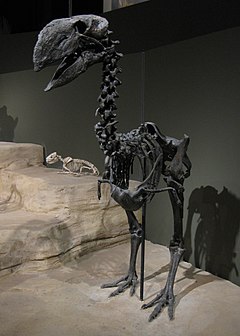
Back غاستورنيس Arabic Gastornis Catalan Gastornis Czech Gastornis Danish Gastornis German Gastornis Spanish سهمگینمرغ Persian Gastornis Finnish Gastornis French Gastornis Galician
| Gastornis | |
|---|---|

| |
| Mounted skeleton of G. gigantea | |
| Scientific classification | |
| Domain: | Eukaryota |
| Kingdom: | Animalia |
| Phylum: | Chordata |
| Class: | Aves |
| Order: | †Gastornithiformes |
| Family: | †Gastornithidae Fürbringer, 1888 |
| Genus: | †Gastornis Hébert, 1855 (vide Prévost, 1855) |
| Type species | |
| †Gastornis parisiensis Hébert, 1855
| |
| Other species | |
| Synonyms | |
| |
Gastornis is an extinct genus of large, flightless birds that lived during the mid-Paleocene to mid-Eocene epochs of the Paleogene period. Fossils have been found in Europe, Asia and North America, with the North American specimens formerly assigned to the genus Diatryma.
Gastornis species were very large birds that were traditionally thought to have been predators of various smaller mammals, such as ancient, diminutive equids. However, several lines of evidence, including the lack of hooked claws (in known Gastornis footprints), studies of their beak structure and isotopic signatures of their bones, have caused scientists to speculate that these birds were potentially herbivorous, feeding on tough plant material and seeds. Gastornis is, generally, agreed to be related to the Galloanserae, the group containing waterfowl and gamebirds.
- ^ Cécile Mourer-Chauviré; Estelle Bourdon (2020). "Description of a new species of Gastornis (Aves, Gastornithiformes) from the early Eocene of La Borie, southwestern France" (PDF). Geobios. 63: 39–46. Bibcode:2020Geobi..63...39M. doi:10.1016/j.geobios.2020.10.002. S2CID 228975095.
© MMXXIII Rich X Search. We shall prevail. All rights reserved. Rich X Search